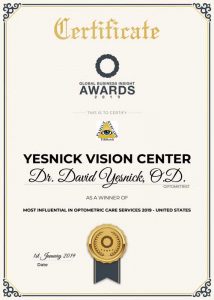Facts about AMD

Age-related macular degeneration is a common eye disease that typically affects people over 50 years old. This condition damages the macula, which is near the center of your retina and responsible for sharp central vision. The macula is what enables you to see objects straight in front of you and fine details.
In some people, AMD progresses so gradually that the individual does not notice any vision problems until the eye disease has advanced to late stage. In addition, this eye disease is painless. An eye exam is therefore the most reliable way to detect age-related macular degeneration when it first begins. Dr. David Yesnick inspects thoroughly for the signs of macular degeneration during comprehensive eye exams at our Las Vegas eye care center.
The Macula
In order to understand macular degeneration and the associated symptoms, it is helpful to familiarize yourself with eye anatomy. The macula is the most sensitive section of the retina, which is located at the back of your eye, and it is comprised of millions of light-sensing cells that give crisp sight in your center field of vision. Your retina transforms light into electrical signals that are sent through the optic nerve to the brain. Your brain then converts the electrical signals into the images that you see.
When the macula suffers damage, one of the first signs is a blurred or dark area near the center of vision. Over time, this distorted area may expand or you may develop blank spots in your central eyesight. Objects may also appear faded, as if the color was washed out.
Effects of Age-Related Macular Degeneration
With AMD, you lose central vision of both near and distance, but peripheral (side) vision generally remains intact. That means you will have difficulty with tasks such as sewing, reading, and driving. Identifying fine details becomes impossible. For example, patients may be able to see the numbers on the edges of a clock, but not the hands to tell time. By itself, AMD does not lead to total blindness, yet the loss of central vision can interfere drastically with daily quality of life and level of independence.
Types of AMD & Treatment
Dry AMD: This type of age-related macular degeneration is relatively common. Approximately 8 of 10 people with AMD have the dry form, which occurs when the macula thins out and drusen (tiny clumps of protein) grow.
Currently, there is no treatment for dry AMD. However, studies show that a certain combination of nutritional supplements may help slow the progression of this eye disease. Ask your Las Vegas eye doctor for more information about these vitamins and minerals and if they recommended for your condition.
Wet AMD: Less common than the dry form, wet AMD is a much more serious eye disease. New, abnormal blood vessels grow under the retina and lead blood or other fluids, which causes scarring. Vision loss is more rapid with wet AMD than with the dry form of the condition.
Treatment for wet AMD includes medications called anti-VEGF therapy, which is injected with a very thin needle. Anti-VEGF drugs help to reduce the amount of abnormal blood vessels in your retina. They also decelerate any leaking from the blood vessels. Laser surgery is another form of treatment for wet AMD. Your eye surgeon will direct a laser beam on the abnormal blood vessels to reduce the quantity and curb leakage.
Risk Factors for AMD
Specific lifestyle and health history conditions are associated with a higher risk of developing AMD. These risk factors include:
- Family history of age-related macular degeneration
- Over 50 years of age
- Cigarette smoking
- Being overweight
- Eating a diet high in saturated fats
- Being Caucasian
- Heart disease
- High cholesterol levels
Diagnosing AMD

Only a comprehensive dilated eye exam can detect the early signs of AMD. Your Las Vegas eye doctor will administer the following tests to inspect for signs of age-related macular degeneration and other eye disease:
- Visual acuity testing: measures your vision at certain distances
- Amsler grid: we may ask you to look at an Amsler grid. If any of the lines are wavy or do not appear, it can point to a change in your central vision and AMD.
- Dilated eye exam: our eye doctor will apply dilating eye drops to obtain a wider, clearer view of the back of your eye. He will then examine your retina and optic nerve for any abnormalities that indicate eye disease.
- OCT Scan: optical coherence tomography uses light waves to capture high-resolution images of living tissues that can be penetrated by light – such as the retina and macula. OCT scans are painless and take only seconds to perform.
To diagnose AMD, Dr. Yesnick checks for medium-to-large sized drusen, which are yellow deposits under the retina. Another diagnostic indication of AMD is the appearance of pigmentary changes beneath the retina, such as dark clumps of released pigment from cells that broke down.
AMD and AREDS 2 Nutritional Supplements
AREDS 2 (Age-Related Eye Disease Study 2) was a massive research study that investigated the benefits of taking daily vitamins and minerals for AMD. Results showed that certain supplements could help patients who have many drusen. Also, it was found that the following nutritional supplements may help with prevention of advanced wet AMD:
- Vitamin E (400 IU)
- Vitamin C (500 mg)
- Lutein (10 mg)
- Zinc (80 mg)
- Zeaxanthin (2 mg)
- Copper (2 mg)
Nutritional supplements are not for everyone, and their effects are also not potent enough to prevent or delay advanced AMD. Eating a well-balanced, healthy diet is also essential. Ask your eye doctor about whether nutritional supplements are appropriate for you.
Age-related Macular Degeneration and Low Vision Rehabilitation
If you have AMD, our Las Vegas Low Vision Specialist can help you maximize your remaining eyesight and live your life to its fullest. A range of low vision devices is available to assist you with many daily tasks. Depending upon your condition and lifestyle needs, we can recommend low vision aids such as computer aids and other technologies, handheld magnifiers, glasses with telescopic lenses, talking electronic devices, and more. The goal of low vision rehabilitation is to help you maintain your independence and optimize your quality of life. Contact our Low Vision Center to schedule a personalized consultation.


